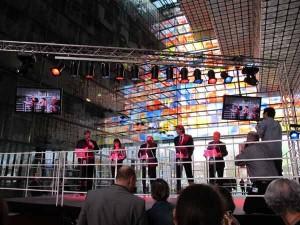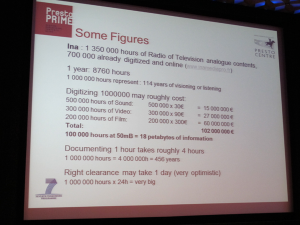Noting Screening The Future
April 12, 2011
While our own Dave Rice was presenting on a panel at the recent Screening the Future symposium in The Netherlands, newest AVPS team member Kara Van Malssen was herself on hand to participate and learn. Here’s her review of the doings that transpired:
Screening the Future
15-16 March 2011
Netherlands Institute for Sound and Vision, Hilversum
Screening the Future: New Challenges and Strategies in Audiovisual Archiving was an intensive two-day event on common challenges and solutions in the audiovisual heritage domain, held at the spectacular Netherlands Institute for Sound and Vision in Hilversum. In a tightly packed schedule, 22 practitioners spoke on digitisation, workflows, digital preservation, sustainability, funding, improving access, and much more. The event marked the launch of the PrestoCentre, a new competence center for digital audiovisual preservation in Europe. A result of the successful European Presto project series (including the completed PrestoSpace and ongoing PrestoPRIME projects), PrestoCentre is a non-profit membership organization which will “provide analysis and advice to custodians and creators of audiovisual content, through online and offline services, publications and training.” There is already a wealth of useful information on their website, which is sure to grow into an indispensable resource for audiovisual archive professionals.

The conference celebrated the successful transition that many European audiovisual archives have made into the digital realm, while simultaneously sparking debate on the many ongoing challenges that these organizations still face: How can we valorize our archives? How can we fund ongoing digital preservation? How can we become more efficient? How should we approach the collection of the flood of born-digital (especially user generated) content that is not currently addressed by traditional heritage organizations? These are big questions, without simple answers.
There was quite a range of topics and speakers. However, given that it was a European event to celebrate European projects and progress, it was interesting to note that a large number of speakers were North American (or based in North America – such as the case of David Rosenthal, British, based in California). Also noteworthy was that only one woman speaker graced the stage over the course of two days (women, we can do better!). In any case, the expertise and experience of all the speakers was inspiring, and nicely balanced technical talks (like the presentation of new preservation planning tools from the IT Innovation Centre in the UK) with broad strokes.

Full presentation available here.
My personal top three presentations of the event addressed complex issues, sparked debate, and were energetic. I felt they left us with a charge, a task to improve, a direction to move toward.
———-
Peter Kaufman’s (Intelligent Television) keynote “Towards a New Enlightenment: Moving Images, Recorded Sound, and the Promise of New Technology” presented an overview of the landscape that audiovisual archives are entering as we move into the digital age, one in which audiovisual content is of equal or greater value than the textual asset (where, in fact, differences of media are evaporating altogether). Referencing Kevin Kelly’s new book, What Technology Wants, Peter whet the audience’s appetite with the notion that the millions of recorded sounds, images that archives are contributing to the web are fueling the electronic mind of the growing planetary electric membrane; we are contributing to the collective synthetic intelligence each time we give a name to an image online, or when we click a link. This global super computer is getting smarter everyday, and video is increasingly becoming part of that intelligence. With new tools like HTML5 and popcorn.js (live web citation and analysis of video content!), video is becoming a more integrated part of the web. There is enormous potential yet to come.
With that introduction, Peter offered 6 recommendations for the PrestoCentre, to help its members build together toward a “Digital Renaissance” – referencing the important recent publication by the European Comité de Sage – rather than a digital dark age. In sum:
- Engage our publics. Peter and Paul Gerhart have been working on this for the JISC-funded project, Film and Sound in Higher and Future Education. This is a marketing challenge, but one that AV archives cannot ignore.
- Engage with Technology. Make our content completely discoverable. Enabling resource discovery is a technical challenge, and involves applying relevant metadata. Users find that the range of user interfaces, search terms, and classifications make it difficult to find what they need. The commercial sector is exploiting the potential of recommendation engines (e.g. Pandora, Netflix). Can we learn from what they do? Google images can search automatically on rights embedded metadata. Wikipedia can crawl and ingest Flickr images that are Creative Commons-licensed. Peter’s recommendation: Develop a research and action plan for engaging with Google and other resources that make content discoverable.
- Facilitate use, clear rights. In order to achieve this, we must collaborate with current owners and their lawyers. Systematically set out the obstacles to making AV content available to education. Using new technology (like popcorn.js) we can actually identify rights holders, unions, and other contributors to a work, and…promote them! Give them credit where credit is due! A novel idea.
- Work with producers. Archival content begins as the point of creation. In the digital era, we can’t afford not to work with them.
- Work with business. Collectively determine best practices for public-private partnerships in AV heritage.
- And one bonus: Work with Americans! (We need your help!)
———-
Brewster Kahle’s energetic presentation, “Scaling Up, Scaling Down: Making the Most of What We Have,” on building cost effective digitization workflows and data centers for large scale digitization preservation had the audience hanging on to his every word (Brewster is certainly one of the most compelling speakers I’ve ever had the pleasure of listening to). His talk was framed around the work that has been accomplished by the Internet Archive (Millions of books digitized! The entire web archived!) on essentially a shoestring budget. Taking a bit of a jab at the Europeans, he pointed out that “large amounts of money give us excuses to not do things.” By focusing on efficiency and lowering costs, the Internet Archive is now able to mass digitize video at $15/hour and film at $200/hour. Off-air television is captured for very little, with Electronic Programming Guide and Closed Caption data extracted to improve searchability. He admits that it takes a lot of money up front to get started, but there are a number of ways to reduce costs over the long-term, such as leveraging the infrastructure of partners, and using your data center to heat your building(!). The Internet Archive measures its own progress in terms of bits in and bits out, and they are doing quite well: outbound they have 10 Gb/s of bandwidth being accessed by 2 million users each day. They are the 200th most popular site on the web, despite the fact that their “user interface is as bad as it gets.” The Internet Archive has so successfully built a cost-effective infrastructure that they can down offer cloud storage, at a cost of 1 terabyte for $2000….forever. That’s a one time payment folks.
Brewster had a lot to say about access as well. He discussed their business model, and how they are able to sustain themselves using a “free to all” access policy. He noted that, “archives make terrible business models,” and argued programs like digital lending are working, without getting the attorneys all heated up. He challenged the audience to think about their mandate as archives: are we just the preservation people, or are we the ones who are going to make stuff available on iPads? With a resounding “shame on us” he chided archives for keeping the best of what we have to offer in our basements, away from the reach of children who learn from what they can find on the Internet. We are not just archives anymore, we must be libraries too. Brewster is ready and willing to partner (for large scale data backup swaps), to offer services (digitization, storage, access), and he is going to do it cheaper and faster than most other organizations. His conclusion: “We get more done because we have less money than you.”
———-
The entire morning of the second day was a panel on “Building Workflows for Digitization and Digital Preservation,” which paired presentations from service providers (Michel Merten, Memnon; Jim Lindner, Media Matters) with representatives from some very large audiovisual archives (Daniel Teruggi, INA; Tobias Golodnoff, Danish Radio; Tom de Smet, Netherlands Institute for Sound and Vision; James Snyder, Library of Congress). At first, I found it surprising that a large portion of the conference was devoted to digitization. After these talks, however, I realized that rather than a series of questions about the challenges of digitization, which has been the focus of many presentations over the past several years, these were digitization success stories: after years of trial and error, millions of hours of audiovisual heritage have been digitized. Something to be proud of, but we still have a long way to go.
Of these talks, I found Jim Lindner’s presentation on improving digitization workflows particularly useful. Jim’s simple argument is that by evaluating every point in the chain, by measuring bottlenecks, we can realized increased efficiencies. Sounds obvious, but turns out to be rarely practiced. Quite often, he finds that the problem isn’t where you might think it is, but perhaps further up the chain. Dependencies in the workflow mean you must untangle entire thing to find the problem, and then fix it.
Jim’s message is to take cues from the real world – security lines at airports, traffic, McDonalds – where efficiency is paramount. Business management and manufacturing literature can be particularly useful to the audiovisual sector. He recommended a number of books (Brussee’s Statistics for Six Sigma Made Easy, Womack and Jones Lean Thinking) but stressed that if you are just going to read one business book, make sure it’s The Goal by Eliyahu M. Goldratt’s (author of Theory of Constraints). Goldratt, and Lindner, press the need to look at the entire system, and identify the constraints, or bottlenecks. These are the places to measure things.
To illustrate the method, Jim used a typical audiovisual digitization workflow, which follows a process of accession → selection → digitization. Most archives perform selection because digitization is expensive, therefore, we shouldn’t digitize everything. But in this workflow, a backlog begins to form, and it isn’t at the digitization stage, where one might assume, but at the selection stage. Turns out, selection requires a surprising number of steps and individuals: choose tapes for selection; identify extant viewing copies, if any; generate viewing copies; view copy; catalog. If there is any bottleneck in this sequential process chain (unable to find copy, no machine to create copy), work stops proceeding. Thus, if we re-examine the overall goal, and look at the available tools to support the entire workflow, it might just make more sense to do the selection on the digital side.
———-
At the conclusion of the event, the moderator, Bernard Smith, along with Jeff Ubois, reviewed the conference themes, and asked the audience if we felt they were adequately covered. Do we know what we are preserving, and are we making the right choices? Have we developed good practices for working with the private sector? Do we have adequate funding models for sustainable digital preservation? Do we know how to best valorize our collections in today’s evolving landscape? The answer was a resounding NO. We have a lot of work left to do. Here’s hoping we’ll reconvene next year to revisit these issues and see how much progress we’ve made.
— Kara Van Malshttps://www.weareavp.com/team/kara-van-malssen/sen